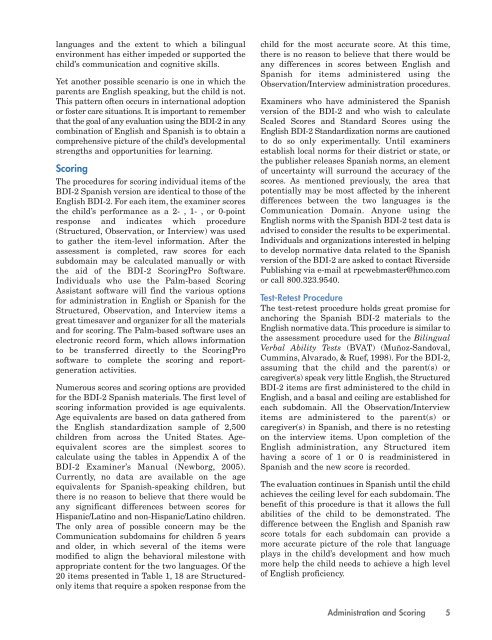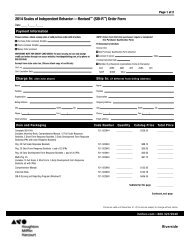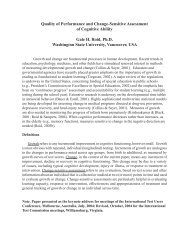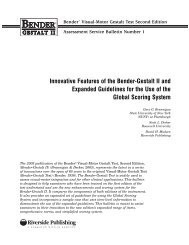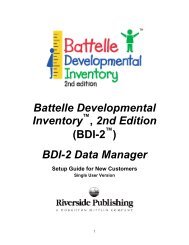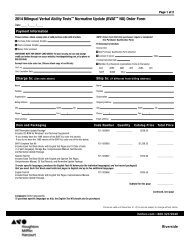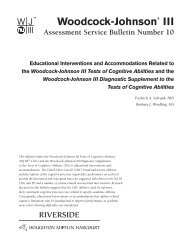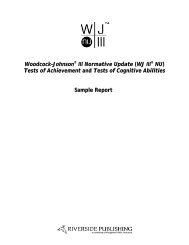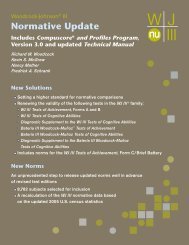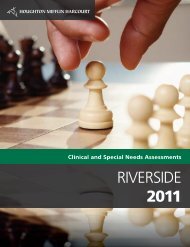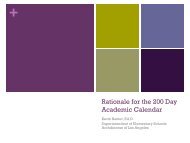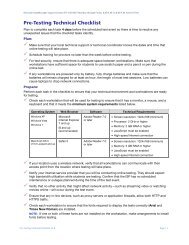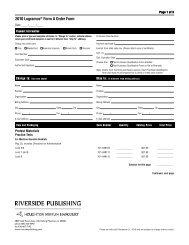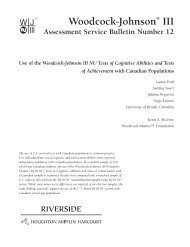User's Guide - Riverside Publishing
User's Guide - Riverside Publishing
User's Guide - Riverside Publishing
You also want an ePaper? Increase the reach of your titles
YUMPU automatically turns print PDFs into web optimized ePapers that Google loves.
languages and the extent to which a bilingualenvironment has either impeded or supported thechild’s communication and cognitive skills.Yet another possible scenario is one in which theparents are English speaking, but the child is not.This pattern often occurs in international adoptionor foster care situations. It is important to rememberthat the goal of any evaluation using the BDI-2 in anycombination of English and Spanish is to obtain acomprehensive picture of the child’s developmentalstrengths and opportunities for learning.ScoringThe procedures for scoring individual items of theBDI-2 Spanish version are identical to those of theEnglish BDI-2. For each item, the examiner scoresthe child’s performance as a 2- , 1- , or 0-pointresponse and indicates which procedure(Structured, Observation, or Interview) was usedto gather the item-level information. After theassessment is completed, raw scores for eachsubdomain may be calculated manually or withthe aid of the BDI-2 ScoringPro Software.Individuals who use the Palm-based ScoringAssistant software will find the various optionsfor administration in English or Spanish for theStructured, Observation, and Interview items agreat timesaver and organizer for all the materialsand for scoring. The Palm-based software uses anelectronic record form, which allows informationto be transferred directly to the ScoringProsoftware to complete the scoring and reportgenerationactivities.Numerous scores and scoring options are providedfor the BDI-2 Spanish materials. The first level ofscoring information provided is age equivalents.Age equivalents are based on data gathered fromthe English standardization sample of 2,500children from across the United States. Ageequivalentscores are the simplest scores tocalculate using the tables in Appendix A of theBDI-2 Examiner’s Manual (Newborg, 2005).Currently, no data are available on the ageequivalents for Spanish-speaking children, butthere is no reason to believe that there would beany significant differences between scores forHispanic/Latino and non-Hispanic/Latino children.The only area of possible concern may be theCommunication subdomains for children 5 yearsand older, in which several of the items weremodified to align the behavioral milestone withappropriate content for the two languages. Of the20 items presented in Table 1, 18 are Structuredonlyitems that require a spoken response from thechild for the most accurate score. At this time,there is no reason to believe that there would beany differences in scores between English andSpanish for items administered using theObservation/Interview administration procedures.Examiners who have administered the Spanishversion of the BDI-2 and who wish to calculateScaled Scores and Standard Scores using theEnglish BDI-2 Standardization norms are cautionedto do so only experimentally. Until examinersestablish local norms for their district or state, orthe publisher releases Spanish norms, an elementof uncertainty will surround the accuracy of thescores. As mentioned previously, the area thatpotentially may be most affected by the inherentdifferences between the two languages is theCommunication Domain. Anyone using theEnglish norms with the Spanish BDI-2 test data isadvised to consider the results to be experimental.Individuals and organizations interested in helpingto develop normative data related to the Spanishversion of the BDI-2 are asked to contact <strong>Riverside</strong><strong>Publishing</strong> via e-mail at rpcwebmaster@hmco.comor call 800.323.9540.Test-Retest ProcedureThe test-retest procedure holds great promise foranchoring the Spanish BDI-2 materials to theEnglish normative data. This procedure is similar tothe assessment procedure used for the BilingualVerbal Ability Tests (BVAT) (Muñoz-Sandoval,Cummins, Alvarado, & Ruef, 1998). For the BDI-2,assuming that the child and the parent(s) orcaregiver(s) speak very little English, the StructuredBDI-2 items are first administered to the child inEnglish, and a basal and ceiling are established foreach subdomain. All the Observation/Interviewitems are administered to the parent(s) orcaregiver(s) in Spanish, and there is no retestingon the interview items. Upon completion of theEnglish administration, any Structured itemhaving a score of 1 or 0 is readministered inSpanish and the new score is recorded.The evaluation continues in Spanish until the childachieves the ceiling level for each subdomain. Thebenefit of this procedure is that it allows the fullabilities of the child to be demonstrated. Thedifference between the English and Spanish rawscore totals for each subdomain can provide amore accurate picture of the role that languageplays in the child’s development and how muchmore help the child needs to achieve a high levelof English proficiency.Administration and Scoring 5


